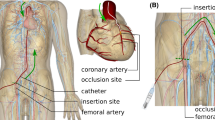Abstract
In this study, we propose a new graph-theoretical method to simulate guidewire paths inside the carotid artery. The minimum energy guidewire path can be obtained by applying the shortest path algorithm, such as Dijkstra’s algorithm for graphs, based on the principle of the minimal total energy. Compared to previous results, experiments of three phantoms were validated, revealing that the first and second phantoms overlap completely between simulated and real guidewires. In addition, 95 % of the third phantom overlaps completely, and the remaining 5 % closely coincides. The results demonstrate that our method achieves 87 and 80 % improvements for the first and third phantoms under the same conditions, respectively. Furthermore, 91 % improvements were obtained for the second phantom under the condition with reduced graph construction complexity.





Similar content being viewed by others
References
Alderliesten T, Bosman PAN, Niessen WJ (2007) Towards a real-time minimally-invasive vascular intervention simulation system. IEEE Trans Med Imaging 26(1):128–132
Alderliesten T, Konings MK, Niessen WJ (2004) Simulation of minimally invasive vascular interventions for training purposes. Comput Aided Surg 9(1–2):3–15
Alderliesten T, Konings MK, Niessen WJ (2007) Modeling friction, intrinsic curvature, and rotation of guide wires for simulation of minimally invasive vascular interventions. IEEE Trans Biomed Eng 54:29–38
Bharadvaj BK, Mabon RF, Giddens DP (1982) Steady flow in a model of the human carotid bifurcation. Part I—flow visualization. J Biomech 15:349–362
Cai Y, Chui C, Ye X, Wang Y, Anderson JH (2003) VR simulated training for less invasive vascular intervention. Comput Graph 27:215–221
Dawson SL, Cotin S, Meglan D, Shaffer DW, Ferrell MA (2000) Designing a computer-based simulator for interventional cardiology training. Catheter Cardiovasc Interv 51(4):522–527
Dijkstra E (1959) A note on two problems in connexion with graphs. Numer Math 1:269–271
Euler L, Carathéodory C (1952) Methodus inveniendi lineas curvas maximi minimive proprietate gaudentes sive solutio problematis isoperimetrici latissimo sensu accepti. Bousquet, Lausannae et Genevae, E65A. O.O. SER. I, Vol 24, 1744
Konings M, Van de Kraats E, Alderliesten T, Niessen W (2003) Analytical guide wire motion algorithm for simulation of endovascular interventions. Med Biol Eng Comput 41(6):689–700
Landwehr P, Schindler R, Heinrich U, Dölken W, Krahe T, Lackner K (1991) Quantification of vascular stenosis with color Doppler flow imaging: in vitro investigations. Radiology 178:701–704
Nowinski WL, Chui C-K (2001) Simulation of interventional neuroradiology procedures. Medical imaging and augmented reality, 2001. Proceedings international workshop on, pp 87–94
Roubin GS, Iyer S, Halkin A, Vitek J, Brennan C (2006) Realizing the potential of carotid artery stenting proposed paradigms for patient selection and procedural technique. Circulation 113(16):2021–2030
Schafer S, Singh V, Hoffmann KR, Noël PB, Xu J (2007) Planning image-guided endovascular interventions: guidewire simulation using shortest path algorithms. In: Medical imaging, vol 6509, pp 65092C-1–65092C-10
Schafer S, Singh V, Noël PB, Walczak AM, Xu J, Hoffmann KR (2009) Real-time endovascular guidewire position simulation using shortest path algorithms. Int J Comput Assist Radiol Surg 4(6):597–608
Wang YP, Chui CK, Cai YY, Mak KH (1997) Topology sorted finite element method analysis of catheter/guidewire navigation in reconstructed coronary arteries. Comput Cardiol 24:529–532
Xu J, Xu L, Xie Y (2010) Approximating minimum bending energy path in a simple corridor. In: Cheong O, Chwa K-Y, Park K (eds) Algorithms and computation, vol 6506. Springer, Berlin, Heidelberg, pp 328–339
Xu L, Tian Y, Jin X, Chen J, Schafer S, Hoffmann K, Xu J (2012) An improved endovascular guidewire position simulation algorithm. 9th IEEE international symposium on biomedical imaging, pp 1196–1199
Yu T, Zhang L (1996) Plastic bending: theory and applications. World Scientific, Singapore
Acknowledgments
The authors thank the Yong Tian from School of Information Science and Engineering of Lanzhou University for providing the original data.
Author information
Authors and Affiliations
Corresponding author
Rights and permissions
About this article
Cite this article
Qiu, J., Qu, Z., Qiu, H. et al. An improved real-time endovascular guidewire position simulation using shortest path algorithm. Med Biol Eng Comput 54, 1375–1382 (2016). https://doi.org/10.1007/s11517-015-1398-0
Received:
Accepted:
Published:
Issue Date:
DOI: https://doi.org/10.1007/s11517-015-1398-0




